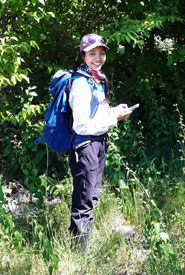Protected doesn’t always mean perfect
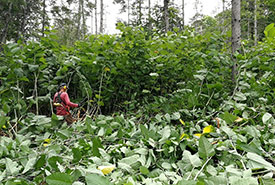
Volunteer cutting the giant knotweed using a hedge trimmer (Photo by NCC)
Imagine frolicking along on a Nature Conservancy of Canada (NCC) property, hoping to stumble upon some neat findings, like rare herptiles and unique plants. But then you look up and scan the landscape to see what may be your worst nightmare: a forested floor of garlic mustard, a stand of invasive phragmites, a riparian zone flooded with Himalayan balsam. You then think to yourself, “Now what?"
During my few years working in conservation with NCC, I have come to realize that being a conservation biologist doesn’t always mean running around looking for plants and animals. While it is important to baseline inventory and collect accurate population data of plants and animals and to ensure species at risk are always at top of mind; what is the point in any of that if you aren’t taking action to protect their habitat? Sometimes you must focus on what may be an immediate threat to the species and landscape you are trying to protect. This usually means pulling out the equipment because it’s time to eradicate!
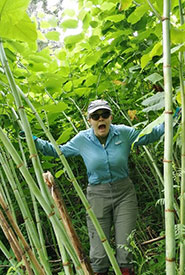
Staff standing under a stand of giant knotweed (Photo by NCC)
It is not uncommon for some NCC properties to support invasive species. Invasive species are easily spread by wind or can hitchhike on people and pets. Even some of our more remote properties, such as those on Cockburn Island in Ontario, require our help in controlling the spread of invasive species.
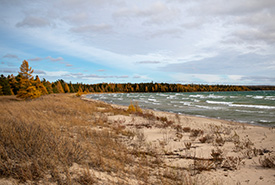
Cockburn Island, Manitoulin Island Archipelago, northern Lake Huron, ON (Photo by Mhairi McFarlane/NCC staff)
Recently, our team travelled to Cockburn Island to tackle giant knotweed. This is an invasive species that not too many people are aware of. The plant is a close look-a-like to Japanese knotweed, another invasive. Whereas Japanese knotweed can grow up to one to three metres, giant knotweed can grow two to four metres tall. Both species grow rapidly and densely, choking out native vegetation.
The giant knotweed patch on the island was known to locals as the “bamboo farm.” For many decades, youths would go to the stands and use the large sturdy and hollow stems to build forts.
In 2019, NCC became aware of the invasion, which happened to occur on private land just south of NCC protected lands. Given the level of threat of this plant on Cockburn Island, NCC collaborated with the landowner and local volunteers to tackle it.
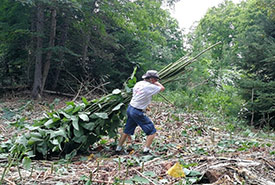
Volunteers helped drag and pile giant knotweed stems (Photo by NCC)
NCC is incredibly grateful to the landowners and residences of Cockburn Island for allowing staff to access the land to initiate control of this threat. Dedicated to the task, staff and volunteers spent 3 1/2 long, hot days of dodging and tripping over cut stems and debris in a robotic-like trance, bending and piling until the last giant knotweed was cut. Then with giant smiles and cheers, everyone walked away from the site with a sense of accomplishment that a good deed was done. Staff will continue to monitor the property annually to control any regrowth.
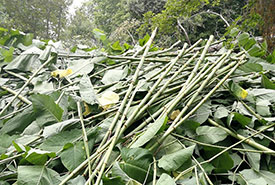
A pile of giant knotweed piled by staff and volunteers (Photo by NCC)
Necessary projects like this one can sometimes be difficult to gain support, as it doesn’t hold the “glamour” of field work. I definitely didn’t see the joy in controlling invasive species when I first started working in conservation. But now I have experienced what it feels like to accomplish the eradication of invasive species like garlic mustard. When I see the return of Jack-in-the-pulpits and branches of red-osier dogwood growing through dead stems of phragmites, it is easy to understand why it is necessary to prioritize the removal of invasive species on all of our properties.
What may seem like a small patch of invasive phragmites one year can easily multiply the next year, destroying riparian shoreline habitat for turtles and waterfowl. What may seem like a few square metres of garlic mustard can spread and outcompete native wildflowers, destroying habitat for ground-nesting birds and vernal pools which provide seasonally wet habitats for sensitive species such as amphibians. It is necessary for us at NCC as land managers to inspect the interior and perimeter of all of our properties yearly and remember that just because the land is protected, it doesn’t mean its ecological integrity is intact. So, if you find yourself feeling daunted by species removal, just remember that you are essential in making a difference. We are all stewards of the land and water.

